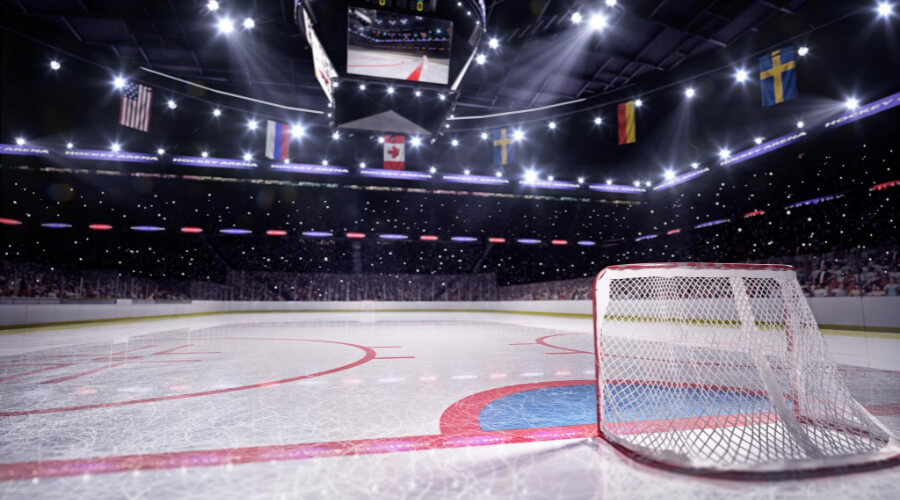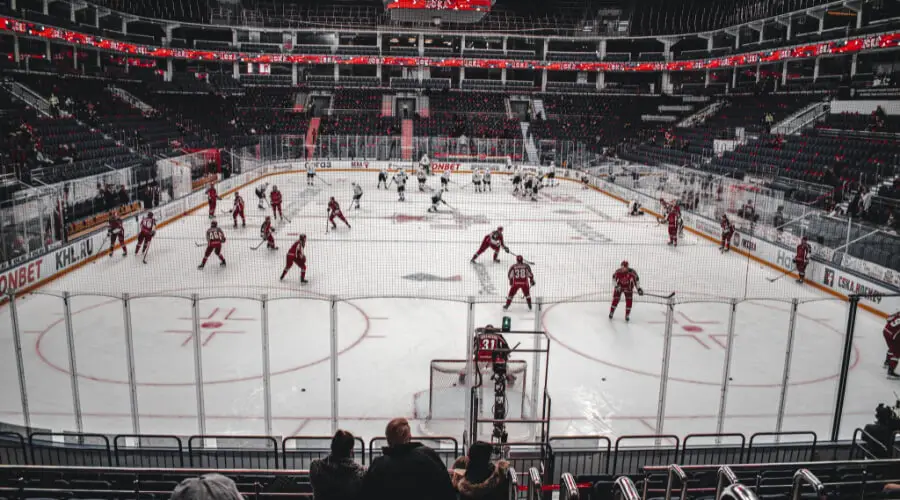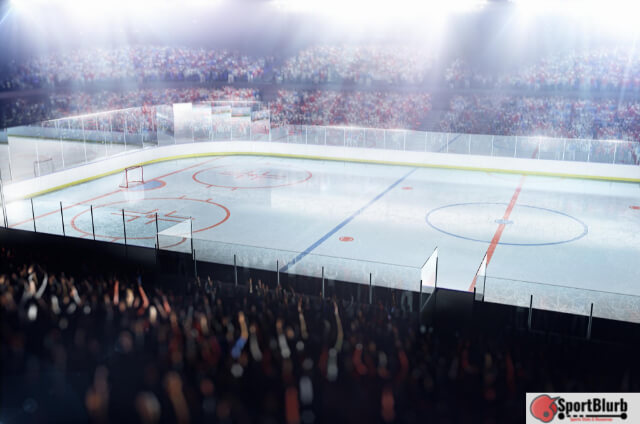Last Updated on October 15, 2023 by Alex PT
The standard National Hockey League specifications of 200 by 85 feet (60.96m × 25.9m) with a corner radius of 28 feet (8.5m) is used in most North American rinks. Besides, NHL blue lines are 50 feet (15.2m) apart and 75 feet (22.9m) from the end boards. From the end boards, each goal line is 11 feet (3.4m).
Ice Thickness, Rink Length, And Width Of The NHL And International Ice Hockey.
| Parameters | NHL | International Ice Hockey |
| Ice Thickness | About one inch | One inch |
| Rink Length | 200 feet | 197 feet |
| Rink Width | 85 feet | 98.4 feet |
Hockey Rink Dimensions And Size

Like we said earlier, the Olympic Games and the NHL rules of dimensions are similar, but there are still some differences. The standard ice hockey rink size for the NHL is the same as the North American rink size. The Olympic Games or International rink size is a little different. The International or Olympic Games rink ice surface is 98.4 feet wide and 197 feet long.
However, the National Hockey League, NHL’s rink ice surface measures 85 feet in width and 200 feet in length. An NHL ice hockey rink is considerably smaller in width but it’s a bit longer than an international or Olympic Games ice hockey rink. You should know that the style of play will be influenced by the changes in the size of the rink. Players will get a more wide-open style of play with more time and space on a wider hockey rink.
Why American hockey rinks are smaller than European rinks
American hockey rinks are smaller than European rinks primarily due to historical and logistical reasons, as well as the distinct styles of play associated with each region:
- Historical Development: The size of hockey rinks in North America, particularly in the United States, was influenced by the historical availability of suitable indoor facilities. Many early American rinks were built within existing structures, which constrained the dimensions. This resulted in the adoption of smaller rinks, often with NHL-standard dimensions (200 feet x 85 feet).
- Logistical Considerations: Smaller rinks were more practical for building facilities within cities and managing operating costs. Smaller rinks allowed for greater seating capacity, making them financially viable for owners and organizations.
- Climate and Space: In Europe, where ice hockey is widely played outdoors, there was more space available to accommodate larger rinks. The size of European rinks also reflects the tradition of playing the sport on larger, open-air surfaces.
- Playing Style: The smaller North American rinks encourage a faster and more physical style of play, emphasizing quick transitions and body checking. This style of play is well-suited to the smaller confines, leading to the development of a distinctive North American brand of hockey.
- European Style: European rinks, being larger, allow for a more open and tactical style of play. Players have more space to maneuver, and the emphasis is often on puck possession and finesse.
- International Differences: The size difference has led to variations in international play. The International Ice Hockey Federation (IIHF) has adopted standardized rink dimensions (200 feet x 100 feet) for international competitions, including the Olympics, which allows teams from both regions to adapt to the larger ice surface.
Historical Hockey Rinks In The World

We’ve prepared a list of some of the famous and historical hockey rinks in the world.
1. The Boston Garden
The two famous hockey players, Phil Esposito and Bobby Orr are among the greatest to ever play in the Boston Garden which is known to be shorter than the standard size. From 1928 to 1995, an ice hockey team called the Bruins used this ice rink as their home ground.
2. Montreal Forum
Some of the greatest players of the game like Ken Dryden, Rocket Richard, and Guy Lafleur all played in the Montreal Forum. Most importantly, the record of 22 NHL titles that the Canadians holds today had all of their home games played in this rink.
3. Maple Leaf Gardens
From 1932 to 1999, all the Toronto Mapie Leaf’s home games were played in the Maple Leaf Gardens.
Lines over lines – how a hockey rink is put together
Constructing a hockey rink involves several steps and layers, with each component contributing to the safety and performance of the playing surface. Here’s a detailed breakdown:
- Base and Insulation:
- The construction typically begins with a solid base, which could be concrete or another durable material.
- Insulation is added to the base to help maintain a consistent ice temperature. Pipes filled with a coolant, such as a brine solution or glycol, are installed within the insulation.
- Refrigeration System:
- An intricate network of pipes, often made of copper or other durable materials, is placed on top of the insulation.
- The refrigeration system circulates the coolant through these pipes, maintaining the ice’s sub-freezing temperature.
- Subfloor and Ice Mat:
- On top of the pipes, a subfloor is typically installed, made of interlocking panels designed to evenly distribute the weight of skaters and provide stability.
- An ice mat, which can be a series of interconnected aluminum or plastic trays, is placed over the subfloor. The ice mat holds a thin layer of water and keeps it in contact with the subfloor’s cooling pipes, allowing the ice to form.
- Ice Surface Layer:
- Once the ice mat is in place, water is sprayed or poured onto it in thin layers, gradually building up the ice surface.
- This process is repeated several times to achieve the desired ice thickness, which is usually around 1 inch (2.54 cm).
- Painting and Lines:
- After the ice has been properly frozen, white paint is applied to create the boundary lines, face-off circles, goal creases, and other markings. Blue or red lines are also painted for offside and icing regulations.
- Boards and Glass:
- The rink is enclosed by boards made of materials like acrylic, tempered glass, or polyethylene. These boards provide player safety and prevent the puck from leaving the playing area.
- Safety Netting and Padding:
- Protective netting is installed above the boards to shield spectators and provide an extra layer of safety.
- Padding is added to the boards to absorb the impact of player collisions.
- Goals and Nets:
- Hockey goals, complete with nets, are placed at each end of the rink. The nets are secured to the ice with pegs or anchors.
- Bench Areas and Penalty Boxes:
- Bench areas for both teams and penalty boxes for players serving penalties are situated along the boards on opposite sides of the rink.
- Scoreboard and Lighting:
- Scoreboards, game clocks, and overhead lighting systems are installed to facilitate gameplay and enhance the spectator experience.
- Locker Rooms and Facilities:
- Nearby facilities house the players’ locker rooms, medical areas, and other amenities required for team preparation and player comfort.
- Seating and Spectator Areas:
- Seating for spectators, including stands and seating arrangements, is positioned around the rink for fans to watch the games.
FAQs
We’ve compiled a list of the frequently asked questions and answers about the ice hockey rink dimension.
What Is The Outdoor Or Backyard Hockey Rink Size?
Depending on the space available outside, an outdoor rink can be built on your preferred size. But the truth is most outdoor rinks are smaller than professional rinks. A rink that measures 88 by 44 feet is ideal for teens and older kids, while a rink that measures 46 by 20 feet is suitable for young skaters.
How Thick Is Hockey Ice?
A well-built ice rink for professional use is about one inch thick. About 10,600 gallons of water are required to make an ice sheet as large as 200 feet long and 85 feet wide.
How Long Is A Hockey Rink?
The length of an ice hockey rink is 60 meters or 197 feet for the International/Olympics Games rink, and a bit longer, at 61 meters or 200 feet for the NHL rink.
Are NHL Rinks All The Same?
Yes! All the rinks in the NHL must have a standard size surface of200 feet long and 85 feet wide with a radius of the corners measuring 28 feet. Every professional team in the NHL must build their rinks according to these standard dimensions. The same goes with the college ice hockey teams.
Are High School Hockey Rinks The Same Size As NHL?
Like we said earlier, the standard ice hockey rink size is 85 by 200 feet, but there’s an exception for lower-tier leagues like high school and children teams. Some teenagers and high school teams are allowed to use smaller and shorter ice rinks.
How Big Is The Offensive Zone In Hockey?
The offensive zone, otherwise known as the attacking zone, is a 75 feet area beyond the second blue line to the far end of the ice rink where an offensive player normally shoots to score a goal. However, the neutral zone is typically the 50 feet area between the two blue lines.
Final Words
The National Hockey League’s rink ice surface measures 85 feet in width and 200 feet in length while the International or Olympic Games rink ice surface measures 98.4 feet wide and 197 feet long. As you can see, the International or Olympic Games ice hockey rink is considerably wider but it’s a bit shorter than an NHL ice hockey. We’ve reached the closing chapter of this informative article. We hope you were able to find good resources in your quest to know ice hockey rink dimensions. If you have any questions or comments about the article topic, don’t hesitate to contact us. Thanks.
References:
https://en.wikipedia.org/wiki/Ice_hockey_rink
https://www.dimensions.com/element/ice-hockey-rink-international

Hi! I’m Alex PT. I hold a Bachelor’s degree in Sports Management from Indiana University and have over seven years of valuable experience working in a Sports Event Management Company. I founded SportBlurb with the passion for bringing you the latest, most insightful, and engaging content in the world of sports. So, whether you’re a die-hard fan or want to stay informed, I’ve got you covered!

